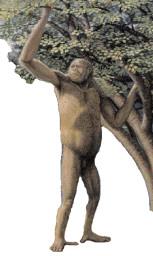The Swamp Ape, a prehistoric primate that once inhabited part of Italy, is the focus of a conference looking at life in this area when it was a tropical island.
The Swamp Ape, or Oreopithecus bambolii, developed some nine million years ago on an island that used to be part of modern-day Tuscany.
''This hominid is the only survivor of what was once tropical Europe,'' explained Lorenzo Rook, who has been studying the creature for many years.
Fossils of the ape, which is closely linked to the orangutan, were first discovered 50 years ago in Grosseto and on the island of Sardinia, near the western town of Sassari.
However, studies on the Swamp Ape have progressed slowly and it is only in the last few years that new breakthroughs have been made.
''We now know that it is not a relation of our most direct forebears,'' said Rook, who works in the Earth Sciences Department of Florence University.
''Instead, it is one of the last members of a large group of human-like apes that were widespread in Europe and Asia during the late Miocene era,'' which ended some 5.33 million years ago.
Research suggests that oreopithecus bambolii lived in a swampy, tropical climate. It had long arms and fingers, probably to help it climb and swing, but also had adaptations suggesting it walked upright, making it among the earliest primates to do so.
It had a small head and large eyes, and its teeth indicate it lived on a diet of berries, fruits and vegetables.
Crucially, it also had hands capable of manipulation similar to that of a human being.
According to Rook, it had more dexterity than any ape alive today and could handle objects with the same precision that was formerly thought to be the exclusive capability of homo sapiens and their direct ancestors.
The Swamp Ape evolved in isolation from other animals on the tropical island, where it appeared to have had no natural predators. However, as sea levels fell with the Ice Age, a land bridge appeared, bringing with it dangerous new species, including large predators, which eventually wiped out the Swamp Ape.
The conference under way in Florence seeks to draw out links among the many species of primate that once occupied Europe in ancient days.
''The Swamp Ape was a genuinely unique animal and the exact nature of its link to other primates is still the subject of much heated debate,'' concluded Rook.









